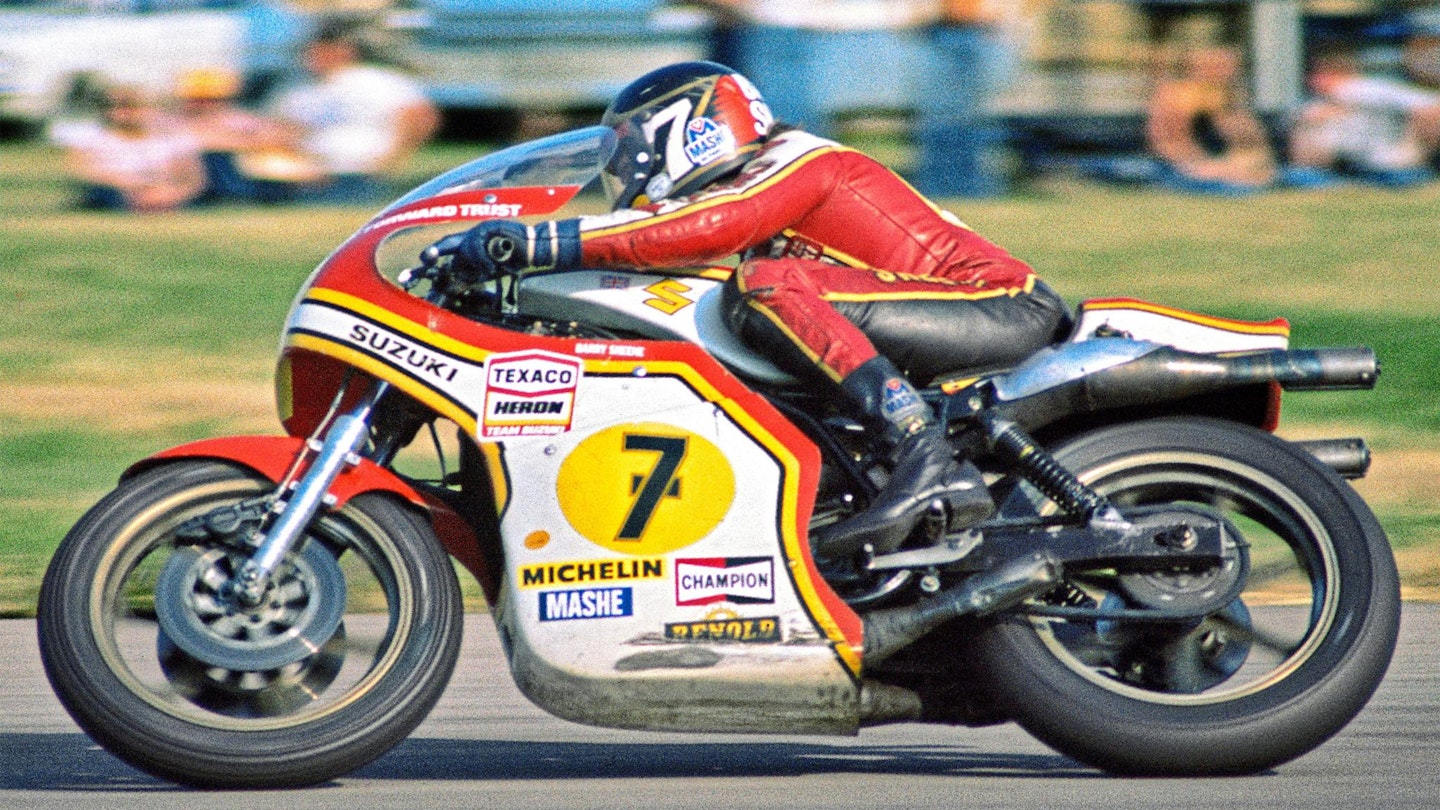SUZUKI RG500 AT 50
Celebrating its 50th birthday this year, Suzuki’s RG500 is the greatest GP bike ever (probably). The squarefour stroker’s domination of the sport led to 11 world titles and world fame for a certain Mr Sheene
Words: MAT OXLEY Photography: BAUER AUTOMOTIVE

Barry Sheene and Suzuki’s RG500 Grand Prix bike go together like fish and chips. Man and machine were mutually beneficial – Sheene probably wouldn’t have won his two 500cc world championships without the RG500, but would the square-four two-stroke have been as good as it was without Sheene’s input?
When Sheene won his second 500cc title in 1977, all but three of the top 29 points scorers rode RGs – and when ‘King’ Kenny Roberts took the crown in 1978, the American was one of only five riders in the top 29 who didn’t ride an RG. In other words, Suzuki’s creation democratised the premier class like no other motorcycle before or since. The RG also won the fastest GP in history – a race average of 217.370kmh (135.067mph) average at Spa-Francorchamps, with Sheene in 1977 – and achieved the final truly privateer victory with Dutchman Jack Middleburg’s defeat of Roberts at Silverstone in 1981.
Suzuki two-strokes had already won the 50cc, 125cc and Formula 750 championship when factory bosses decided to fight for the prize that would really put the Hamamatsu brand in the headlines and hopefully sell more of their two-stroke road bikes. The company already had a 500 Grand Prix bike, but the XR11 was powered by a tuned GT500 street engine, so it was never going to challenge for global glory. Instead, Suzuki entered the XR11 in the 1973 500cc world championship as a rolling surveillance operation, gathering information on the dominant MV Agusta fourstroke and Yamaha’s first 500cc GP machine, the fourcylinder 0W20 two-stroke, which had arrived in Europe at the start of that season.

Back in Japan, chief engineer Makoto Hase went to work on the company’s second square-four GP bike, making sure not to repeat the mistakes made with the RZ63 square-four 250, which raced in the 1960s and never came close to winning a GP. Whereas the RZ63 was basically two 125cc parallel twins geared together, the RG was four 125 singles geared together. This had various advantages. For example, 1970s two-strokes were fickle things, liable to detonate or seize at any time, so keeping each cylinder separate prevented damage to one cylinder from infecting the others.
Sheene was involved in the RG – the first iterations were designated XR14 – from the start. Just weeks after the very first RG was bumped into life at Suzuki’s Ryuyo test track in the autumn of 1973, Sheene was on a plane to Japan to test the bike. First time out he broke the Ryuyo lap record by 1.5 seconds. Despite his speed, Sheene wasn’t that impressed by the protype: “The first RG I rode at the end of ’73 started at nine grand. Below that, there was nothing – and when I say nothing, I mean nothing,” Sheene told me many years ago. “To get it out of the paddock you had to scream it at 10,000rpm or it wouldn’t even clear – and it stopped at ten-five, so once you’d got it clear at nine-five, you had 1000rpm to play with. I told them it was a waste of time unless they spread the powerband.”

Suzuki shipped its first RGs to Europe in time for the 1974 season-opening French GP, where the bike encountered its rivals for the first time: the MV, ridden by Phil Read, and the 0W20, ridden by Giacomo Agostini, who had recently defected from MV. Both machines made around one hundred horsepower, so this was GP racing’s crossover point between four-stroke and two-stroke. Ultimately there would only be one winner, but the French GP flattered to deceive. Sheene finished second, between winner Read and his MV team-mate Gianfranco Bonera.
A few weeks later, at Austria’s daunting Salzburgring, he was lapped by both Agostini and Bonera. The RG certainly wasn’t ready to rock straight out of the box. “Foolishly Barry, looking very young, with the original G-54 version of the bike, looking very spindly. The open cradle chassis had no lower chassis rails in a bid to reduce weight, but it was soon replaced by a conventional double-cradle design enough I told Suzuki I’d go to Japan at the end of ’74 and stay there until the engine was right,” Sheene added. “I was there for five weeks, the biggest jail sentence I’ve ever served in my life; a nightmare, but the bike came good.”
‘The first RG I rode at the end of ’73 started at nine grand. Below that there was nothing – and when I say nothing, I mean nothing’

Of course, the RG wasn’t entirely a Japanese creation, because Suzuki’s two-stroke knowhow was the product of skullduggery. In the early 1960s the only company making fast two-strokes was East German brand MZ. Suzuki decided to accelerate its learning curve via industrial espionage.
It paid MZ’s number-one rider Ernst Degner to defect from East to West and bring MZ’s secrets with him.
The RG was basically four MZ 125 rotary-valve singles in a square format. The only real difference was its bore and stroke: 56 x 50.5mm, instead of 54 x 54. And that only lasted until 1976 when Hase switched to 54 x 54, the longer stroke allowing bigger ports. Using rotary-valve induction gave the RG a significant advantage. Yamaha’s 0W20 used basic piston-porting, which handicaps performance by restricting the engine to symmetrical valve timing. Rotary valves allow inlet tracts to open and close at the ideal time, for a better blend of peak power and midrange.
To read more, head into stores and grab the latest issue of Classic Bike, or why not subscribe today and get 3 issues for just £5! But hurry, offer ends 31st August!

